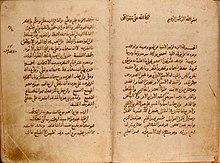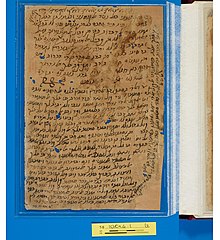
An autograph is a person's own handwriting or signature. The word autograph comes from Ancient Greek, and can mean more specifically:

The Mass in B minor, BWV 232, is an extended setting of the Mass ordinary by Johann Sebastian Bach. The composition was completed in 1749, the year before the composer's death, and was to a large extent based on earlier work, such as a Sanctus Bach had composed in 1724. Sections that were specifically composed to complete the Mass in the late 1740s include the "Et incarnatus est" part of the Credo.

The sonatas and partitas for solo violin are a set of six works composed by Johann Sebastian Bach. They are sometimes referred to in English as the sonatas and partias for solo violin in accordance with Bach's headings in the autograph manuscript: "Partia" was commonly used in German-speaking regions during Bach's time, whereas the Italian "partita" was introduced to this set in the 1879 Bach Gesellschaft edition, having become standard by that time. The set consists of three sonatas da chiesa in four movements and three partitas in dance-form movements. The 2nd Partita is widely known for its Chaconne, considered one of the most masterly and expressive works ever written for solo violin.

Sechs Chorale von verschiedener Art: auf einer Orgel mit 2 Clavieren und Pedal vorzuspielen, commonly known as the Schübler Chorales, BWV 645–650, is a set of chorale preludes composed by Johann Sebastian Bach. Johann Georg Schübler, after whom the collection came to be named, published it in 1747 or before August 1748, in Zella St. Blasii. At least five preludes of the compilation are transcribed from movements in Bach's church cantatas, mostly chorale cantatas he had composed around two decades earlier.
"Bist du bei mir, geh ich mit Freuden" is an aria from Gottfried Heinrich Stölzel's opera Diomedes, which was first staged on 16 November 1718. The aria is best known as "Bist du bei mir," BWV 508, a version for voice and continuo found as No. 25 in the 1725 Notebook for Anna Magdalena Bach.

The Oboe Concerto in D minor, S D935, is an early 18th-century concerto for oboe, strings and continuo attributed to the Venetian composer Alessandro Marcello. The earliest extant manuscript containing Johann Sebastian Bach's solo keyboard arrangement of the concerto, BWV 974, dates from around 1715. As a concerto for oboe, strings and continuo its oldest extant sources date from 1717: that year it was printed in Amsterdam, and a C minor variant of the concerto, S Z799, was written down.

Johann Ernst of Saxe-Weimar was a German prince, son by his second marriage of Johann Ernst III, Duke of Saxe-Weimar. Despite his early death he is remembered as a collector and commissioner of music and as a composer, some of whose concertos were arranged for harpsichord or organ by Johann Sebastian Bach, who was court organist in Weimar at the time.
Most of Johann Sebastian Bach's extant church music in Latin—settings of the Mass ordinary and of the Magnificat canticle—dates from his Leipzig period (1723–50). Bach started to assimilate and expand compositions on a Latin text by other composers before his tenure as Thomaskantor in Leipzig, and he continued to do so after he had taken up that post. The text of some of these examples by other composers was a mixture of German and Latin: also Bach contributed a few works employing both languages in the same composition, for example his early Kyrie "Christe, du Lamm Gottes".
Was mir behagt, ist nur die muntre Jagd, BWV 208.2 and 208.3 both also BWV 208a, are later versions of Johann Sebastian Bach's Hunting Cantata, BWV 208.1, BWV 208. Like the original cantata, which was first performed in Weißenfels in 1713, the two later versions belong to the body of around 50 known secular cantatas by Bach. The BWV 208.2 and 208.3 versions survived as later additions to Bach's autograph score of BWV 208.1:

The Kyrie–Gloria Mass for double choir, BWV Anh. 167, is a mass composition in G major by an unknown composer. The work was likely composed in the last quarter of the 17th century. The composition has two sections, a Kyrie and a Gloria, each subdivided in three movements. It has twenty-two parts for performers: twelve parts for singers, and ten for instrumentalists, including strings, wind instruments and organ. Johann Sebastian Bach may have encountered the work around 1710, when he was employed in Weimar. In the 1730s he produced a manuscript copy of the Mass.

Prelude and Fugue in E minor, BWV 548 is a piece of organ music written by Johann Sebastian Bach sometime between 1727 and 1736, during his time in Leipzig. The work is sometimes called "The Wedge" due to the chromatic outward motion of the fugue theme. Unlike most other organ preludes and fugues of Bach, the autograph fair copy of the score survives, though the handwriting changes twenty two measures into the fugue to the hand of Johann Peter Kellner, a likely pupil and acquaintance of Bach who played an important role in the copying of his manuscripts. Because of the work's immense scope, it has been referred to as "a two-movement symphony" for the organ.
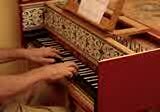
Twelve Little Preludes, BWV 924–930, 939–942 and 999, is a 19th-century compilation of short pieces, collected from various 18th-century manuscripts written by Johann Sebastian Bach and others. Notwithstanding their diverse origin and characteristics, they were published as a set of twelve keyboard preludes by Bach in, amongst others, the 36th volume of the Bach-Gesellschaft Ausgabe (BGA).
The Triple Concerto, BWV 1044, is a concerto in A minor for traverso, violin, harpsichord, and string orchestra by Johann Sebastian Bach. He based the composition on his Prelude and Fugue BWV 894 for harpsichord and on the middle movement of his Organ Sonata BWV 527, or on earlier lost models for these compositions.
The concerto transcriptions of Johann Sebastian Bach date from his second period at the court in Weimar (1708–1717). Bach transcribed for organ and harpsichord a number of Italian and Italianate concertos, mainly by Antonio Vivaldi, but with others by Alessandro Marcello, Benedetto Marcello, Georg Philipp Telemann and the musically talented Prince Johann Ernst of Saxe-Weimar. It is thought that most of the transcriptions were probably made in 1713–1714. Their publication by C.F. Peters in the 1850s and by Breitkopf & Härtel in the 1890s played a decisive role in the Vivaldi revival of the twentieth century.

Johann Sebastian Bach wrote his fifth Brandenburg Concerto, BWV 1050.2, for harpsichord, flute and violin as soloists, and an orchestral accompaniment consisting of strings and continuo. An early version of the concerto, BWV 1050.1, originated in the late 1710s. On 24 March 1721 Bach dedicated the final form of the concerto to Margrave Christian Ludwig of Brandenburg.
The Fantasia or Pièce d'Orgue in G major, BWV 572, is a composition for organ by Johann Sebastian Bach.

Prelude and Fugue in B minor, BWV 544 is a piece of organ music written by Johann Sebastian Bach sometime between 1727 and 1731, during his tenure in Leipzig. Unlike most other organ preludes and fugues of Bach, the autograph fair copy of the score survives.
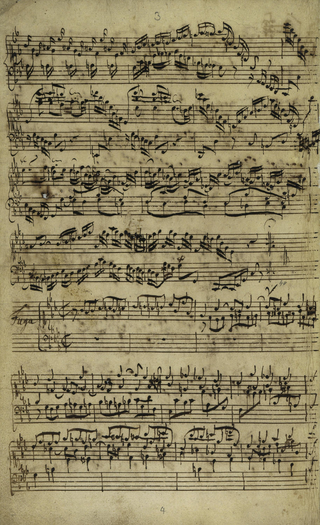
Fantasia and Fugue in C minor, BWV 906, is a keyboard piece, likely unfinished, composed by Johann Sebastian Bach sometime during his tenure in Leipzig (1723–1750). The work survives in two autograph scores, one with the fantasia alone, and the other, believed to have been penned around 1738 in which the fugue is incomplete. The piece is notable for being one of Bach's latest compositions in the prelude and fugue format, and for being a showcase of Bach trying his hand at the emerging galant and empfindsam styles of music that his sons were known to compose.
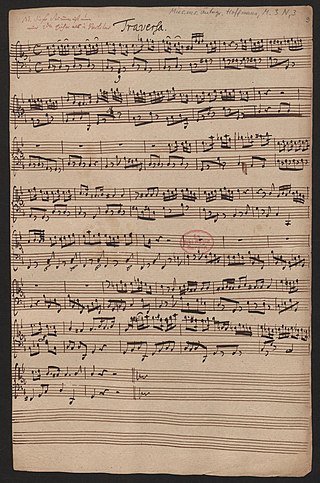
The Magnificat in A minor, BWV Anh. 21, TWV 1:1748, is Melchior Hoffmann's musical setting of a German version of the Song of Mary from the Gospel of Luke. The composition originated around 1707, when the composer was director musices and organist of the Neue Kirche in Leipzig. Composed in A minor, the Magnificat is scored for soprano and small orchestra. The work was first published in the 1950s, and it was recorded by Magda László, by Joshua Rifkin, by Wolfgang Helbich, and by Deborah York, among others.
